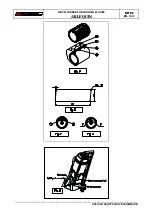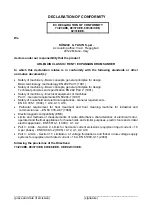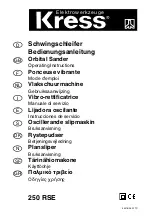
DRUM SANDER FOR WOODEN FLOORS
ARLEQUIN
ED 04
PG.
13/19
USE AND MAINTENANCE HANDBOOK
ARLEQUIN CLASSIC (drum for classic type)
Abrasive has to be prepared in the dimensions indicated in
fig. E
and it has to be cut absolutely with the
inclination which is showed in the picture. By means of the proper keys, turn the two tensioning shafts
pos. 1
e 2 fig. F
until the two flat sides of the tensioning shafts are face to face. Insert one abrasive edge for approx.
2/3 of the drum cut depth and turn the drum being careful that the abrasive sticks to the rubber; once you get
to the cut, insert the other edge of the abrasive until it is uniformly stretched. Take the two edges out of the
cut, uniformly, for approx. 5 mm., as shown in
fig.
F.
Turn the tensioning shafts one opposite the other until
you get the right and regular tensioning of the abrasive. In the end, the
P
planes of the shaft have to be
approx. as indicated in
fig. G.
In case the abrasive should not be uniformly tight, after carrying out the a.m. operations, please repeat the
instructions adjusting the introduction of the abrasive until you get the correct and regular tensioning. The
a.m. procedure is needed for setting of coarse grain abrasive
(20-24).
For medium and fine abrasive
(36-60-
80 etc…)
. it is necessary to put one or even more abrasive stripes between the two edges, which should be as
large as the drum and of approx. 30 mm. of height, in order to compensate for the difference in thickness
between the coarse and the medium/fine grain abrasive
WARNING:
The abrasive is in the correct position when it protrudes from the sanding
drum by about 1.5 mm.
DANGER:
If you use abrasive which is damaged or not well tightened, it may tear
while sanding and cause damages to the machine and to the floor
PERIODIC MAINTENANCE
To keep the machine in good working order, the following items must be periodically checked and maintained:
VACUUM UNIT (for the user)
Check periodically the condition of the fabric filter, by eliminating the residues with a slight shaking of the same
filter. The continual and correct use of the paper bags, which are to be used once and then thrown away,
prevents in any case every risk of stoppage of the filter.
DUST BAG (for the user)
Remove the bag and replace it before it is completely full. Do not use the paper bag again but always
substitute it with a new one.
DRUMS (for the user)
Check periodically the external surface of the sanding drum. Remove any dirt.
WHEELS (for the user)
Remove periodically any dirt from the machine body and wheels. Accumulated dirt, modifing wheels planarity,
may cause undulations on the sanded surface.





































